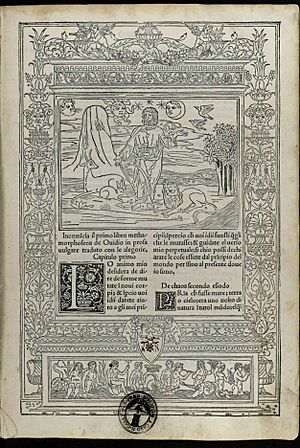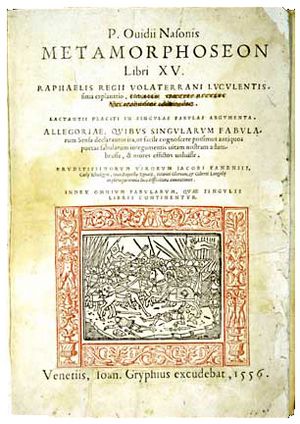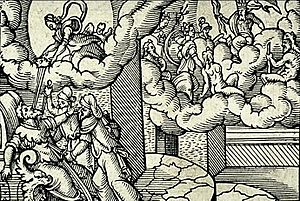Metamorphoses facts for kids
| by Ovid | |

Page from the edition of Ovid's Metamorphoses published by Lucantonio Giunti in Venice, 1497
|
|
| Original title | Metamorphoses |
|---|---|
| First published in | 8 CE |
| Language | Latin |
| Genre(s) | Narrative poetry, epic, elegy, tragedy, pastoral (see What is the Metamorphoses about?) |
The Metamorphoses (Latin: Metamorphōsēs, meaning "Transformations") is a long Latin poem written around 8 CE. It was created by the Roman poet Ovid. Many people consider it his greatest work.
This amazing poem tells the history of the world. It starts from the very beginning, with the creation of the world. It then goes all the way to the time when Julius Caesar became a god. The poem uses over 250 myths and is divided into 15 books. It has almost 12,000 lines!
Even though it's a very long poem, it's hard to put it into just one category. It has many different themes and moods. Ovid was inspired by other poems about transformations. He also used some myths that had been told before. But he changed them a lot to make them his own.
The Metamorphoses is one of the most important works in Western culture. It has inspired many famous writers. These include Dante Alighieri, Giovanni Boccaccio, Geoffrey Chaucer, and William Shakespeare. Many parts of the poem have also been shown in art. You can find them in sculptures, paintings, and music. This was especially true during the Renaissance period. Even today, the Metamorphoses continues to inspire new stories and art.
Contents
How Ovid Got His Ideas
Ovid showed that he had read earlier versions of myths. But he could still tell the stories in his own way.
Ovid decided to make myths the main topic of his Metamorphoses. He was influenced by Alexandrian poetry. In that style of poetry, myths were used to teach lessons or give insights. But Ovid used myths more for fun and to show off his artistic skills.
He found a model for his collection of transformation myths in older Greek poetry. One example was Ornithogonia by Boio(s). This poem, which is now mostly lost, collected myths about humans changing into birds.
There were other similar poems by later Greek writers. We don't know much about them. But we do know about the Heteroioumena by Nicander of Colophon. This work clearly influenced Ovid. He used 21 stories from Nicander's poem in his Metamorphoses.
However, Ovid changed things a lot from his sources. This was common for writers of his time. The Metamorphoses was much longer than any previous collection of transformation myths. Nicander's work probably had only four or five books. Ovid's poem also placed the myths within a historical timeline.
Some of the Metamorphoses stories came from earlier writings and poems. The quality of these older materials varied. Some were "finely worked," meaning they were very detailed. Other times, Ovid might have had only limited information to work with. For example, the myth of Io in Book I was very popular. It had been told in literature since the 5th century BC. Ovid reorganized and added new ideas to these existing stories. He did this to highlight his favorite topics. He also used them to show the main ideas of the Metamorphoses.
What is the Metamorphoses about?
Scholars have found it hard to decide what type of poem the Metamorphoses is. Some call it an epic poem. Others call it an "anti-epic" or "mock-epic." Some see it as a collection of many small stories. Or simply a story that doesn't fit into any one category.
The poem does have many features of an epic. It is very long, with over 250 stories in 15 books. It is written in dactylic hexameter. This was the same meter used in ancient epics like the Iliad and Odyssey. It was also used in the more recent epic, the Aeneid. The poem also deals with important myths.
However, the poem uses themes and tones from almost every type of literature. It goes from epic and elegy (a sad poem) to tragedy and pastoral (poems about nature). Because of this, many experts agree that it's hard to give the Metamorphoses just one label.
The Metamorphoses covers a huge timeline. It starts with the creation of the world. It ends with the death of Julius Caesar. Caesar died only a year before Ovid was born. Because of its wide scope, the poem has been compared to works of universal history. These types of histories became popular in the 1st century BC.
Even though it seems to follow a continuous timeline, one scholar, Brooks Otis, found four main parts:
- Book I – Book II (end): The Divine Comedy (stories about gods)
- Book III – Book VI, 400: The Avenging Gods (gods punishing humans)
- Book VI, 401 – Book XI (end): The Pathos of Love (sad stories about love)
- Book XII – Book XV (end): Rome and the Deified Ruler (stories about Rome and its leaders)
Ovid moves through his stories in a unique way. He often jumps from one transformation tale to another. Sometimes he retells famous Greek myths. Other times, he goes in unexpected directions. The poem begins with a traditional "invocation of the muse". This is when a poet asks a goddess for inspiration. It also uses traditional epithets (descriptive names) and long phrases.
But instead of focusing on one human hero, the poem jumps from story to story. There is often little connection between them. The main theme, like in most of Ovid's work, is love. This can be personal love or love shown through the god Amor (Cupid).
In fact, the other Roman gods are often confused and made to look silly by Amor. He is a relatively minor god in the pantheon (group of gods). But he is almost like the hero of this poem. Apollo is often made fun of. Ovid shows how irrational love can make even a wise god lose his reason. The poem often flips the usual order. It raises humans and their feelings. It makes the gods and their desires seem funny.
The Metamorphoses ends with a short conclusion (Book XV.871–879). It is one of only two surviving Latin epic poems to do this. The other is Thebaid by Statius. The ending declares that everything changes except his poetry. Even Rome itself must change.
Now stands my task accomplished, such a work
As not the wrath of Jove, nor fire nor sword
Nor the devouring ages can destroy.
How the Poem Influenced Others
No work from ancient times, Greek or Roman, has had such a lasting influence on European literature as Ovid's Metamorphoses. You can't fully understand French, English, and Italian literature from the late Middle Ages without knowing about this amazing poem. The only other works that might compare in influence are perhaps the Old Testament and the works of Shakespeare.
The Metamorphoses has had a huge impact on literature and art. This is especially true in the West. One scholar, A. D. Melville, said it's doubtful if any other poem has influenced Western literature and art as much. Many of its stories didn't start with Ovid. They came from writers like Hesiod and Homer. But for some myths, Ovid's poem is the only source we have.
The poem greatly influenced the works of Geoffrey Chaucer. In The Canterbury Tales, the story of Coronis and Phoebus Apollo (from Book II) was used. It became the basis for The Manciple's Tale. The story of Midas (from Book XI) is also mentioned. It appears, though much changed, in The Wife of Bath's Tale. Chaucer also used the story of Ceyx and Alcyone (from Book IX). He adapted it in his poem The Book of the Duchess. This poem was written to remember Blanche, Duchess of Lancaster. She was the wife of John of Gaunt.
The Metamorphoses also had a big impact on William Shakespeare. His play Romeo and Juliet was influenced by the story of Pyramus and Thisbe (from Metamorphoses Book IV). And in A Midsummer Night's Dream, a group of amateur actors performs a play about Pyramus and Thisbe. Other English writers inspired by the Metamorphoses include John Milton. He used it in Paradise Lost, his greatest work. He clearly knew Ovid's poem very well. Edmund Spenser was also influenced by it. In Italy, the poem influenced Giovanni Boccaccio. The story of Pyramus and Thisbe appears in his poem L'Amorosa Fiammetta. It also influenced Dante.
During the Renaissance and Baroque periods, artists often painted mythological subjects. The Metamorphoses was the main source for these stories. So much so that the term "Ovidian" often meant "mythological" during this time. Many stories from the Metamorphoses became famous paintings and sculptures. This was especially true during these periods.
Some of the most famous paintings by Titian show scenes from the poem. These include Diana and Callisto, Diana and Actaeon, and Death of Actaeon. These works are part of Titian's "poesie". This was a collection of seven paintings inspired by ancient Greek and Roman myths. They were brought together for an exhibition at The National Gallery in 2020.
Other famous artworks inspired by the Metamorphoses include Pieter Brueghel's painting Landscape with the Fall of Icarus. Also, Gian Lorenzo Bernini's sculpture Apollo and Daphne. The ideas of transformation in the Metamorphoses also influenced art theory. The myths of Pygmalion and Narcissus were important to how artists thought about their work.
Although Ovid was popular for many centuries, interest in his work faded after the Renaissance. His influence on writers in the 1800s was small. But towards the end of the 1900s, his work became popular again. Ted Hughes collected and retold 24 passages from the Metamorphoses in his book Tales from Ovid (1997). In 1998, Mary Zimmerman's play Metamorphoses opened. The next year, the Royal Shakespeare Company adapted Tales from Ovid. In the early 2000s, the poem continues to inspire new books, films, and plays.
See also
 In Spanish: Las metamorfosis para niños
In Spanish: Las metamorfosis para niños
- Isis (Lully), a French opera based on the poem
- List of Metamorphoses characters
- Tragedy in Ovid's Metamorphoses



